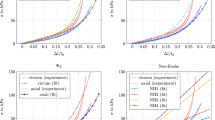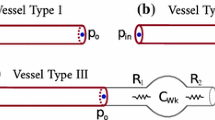Abstract
Blood flow distributions were evaluated using various computational strategies. Three commonly used wall conditions in arterial modeling were employed, namely rigid, dynamic and compliant walls. The results show that the velocity distributions are similar under rigid and dynamic walls, developing into the Poiseuille flow, but they are blunt under compliant walls. The peak pressure under rigid walls is highest, but the model of dynamic walls has a good approximation of pressure against the model of compliant walls. The results indicate that a model of compliant walls appears to be a computationally and reasonably accurate approximation of blood velocity distributions compared with the analysis under rigid or dynamic walls. Introducing fluid-structure interaction into arterial modeling is necessary to ensure reliable results and information. However, a model of dynamic walls seems to be a computationally inexpensive yet reasonably accurate approximation for pressure.
Similar content being viewed by others
References
L. Antiga, B. Ene-Iordache, L. Caverni, G. P. Cornalba and A. Remuzzi, Geometric reconstruction for computational mesh generation of arterial bifurcations from CT angiography, Computerized Medical Imaging and Graphics, 26 (4) (2002) 227–235.
D. C. Barratt, B. B Ariff, K. N. Humphries, S. A. McG Thom and A. D. Hughes, Reconstruction and quantification of the carotid artery bifurcation from 3-D ultrasound images, IEEE Transactions on Medical Imaging, 23 (5) (2004) 567–583.
F. P. Glor, Q. Long, A. D. Hughes, A. D. Augst, B. Ariff, S. A. McG. Thom, P. R. Verdonck and X. Y. Xu, Reproducibility study of magnetic resonance image-based computational fluid dynamics prediction of carotid bifurcation flow, Annals of Biomedical Engineering, 31 (2) (2003) 142–151.
J. B. Thomas, J. S. Milner, B. K. Rutt and D. A. Steinman, Reproducibility of image-based computational fluid dynamics models of the human carotid bifurcation, Annals of Biomedical Engineering, 31 (2) (2003) 132–141.
Q. Long, X. Y. Xu, K. V. Ramnarine and P. Hoskins, Numerical investigation of physiologically realistic pulsatile flow through arterial stenosis, Journal of Biomechanics, 34 (2001) 1229–1242.
J. S. Cole, J. K. Watterson and M. J. G. O’Reilly, Numerical investigation of the haemodynamics at a patched arterial bypass anastomosis, Medical Engineering & Physics, 24 (2002) 393–401.
Y. Liu, Y. Lai, A. Nagaraj, B. Kane, A. Hamilton, R. Greene, D. D. McPherson and K. B. Chandran, Pulsatile flow simulation in arterial vascular segments with intravascular ultrasound images, Medical Engineering & Physics, 23 (2001) 583–595.
S. Balocco, O. Basset, G. Courbebaisse, P. Delachartre, P. Tortoli and C. Cachard, 3D dynamical ultrasonic model of pulsating vessel walls, Ultrasonics, 44 (2006) e179–e183.
D. Tang, C. Yang, H. Walker, S. Kobayashi and D. N. Ku, Simulating cyclic artery compression using a 3D unsteady model with fluid-structure interactions, Computers and Structures, 80 (2002) 1651–1665.
Z. Li and C. Kleinstreuer, Fluid-structure interaction effects on sac-blood pressure and wall stress in a stented aneurysm, Journal of Biomechanical Engineering, 127 (2005) 662–671.
X. L. Yang, Y. Liu and J. M. Yang, Fluid-structure interaction in a pulmonary arterial bifurcation, Journal of Biomechanics, 40 (2007) 2694–2699.
A. Borghi, N. B. Wood, R. H. Mohiaddin and X. Y. Xu, Fluid-solid interaction simulation of flow and stress pattern in thoracoabdominal aneurysms: A patient-specific study, Journal of Fluids and Structures, 24 (2008) 270–280.
F. J. H. Gijsen, E. Allanic, F. N. van de Vosse and J. D. Janssen, The influence of the non-Newtonian properties of blood on the flow in large arteries: unsteady flow in a 90° curved tube, Journal of Biomechanics, 32 (7) (1999) 705–713.
E. S. Weydahl and J. E. Moore, Dynamic curvature strongly affects wall shear rates in a coronary artery bifurcation model, Journal of Biomechanics, 34 (2001) 1189–1196.
Y. L. Lu, X. Y. Lu, L. X. Zhuang and W. Wang, Breaking symmetry in non-planar bifurcation: distribution of flow and wall shear stress, Biorheology, 39 (2002) 431–436.
T. J. Pedley, The fluid mechanics of large blood vessels, Cambridge University Press, London (1980).
F. He, Wave propagation in an elastic tube: a numerical study, International Journal of Computational Fluid Dynamics, 27 (3) (2013) 164–172.
J. P. Abraham, E. M. Sparrow and R. D. Lovik, Unsteady, three-dimensional fluid mechanic analysis of blood flow in plaque-narrowed and plaque-free arteries, International Journal of Heat and Mass Transfer, 51 (2008) 5633–5641.
T. Gebreegziabher, E. M. Sparrow, J. P. Abraham, E. Ayorinde and T. Singh, High-frequency pulsatile pipe flows encompassing all flow regimes, Numerical Heat Transfer A, 60 (2011) 811–826.
I. V. Pivkin, P. D. Richardson, D. H. Laidlaw and G. E. Karniadakis, Combined effects of pulsatile flow and dynamic curvature on wall shear stress in a coronary artery bifurcation model, Journal of Biomechanics, 38 (2005) 1283–1290.
K. Rhee and S. M. Lee, Effects of radial wall motion and flow waveform on the wall shear rate distribution in the divergent vascular graft, Annals of Biomedical Engineering, 26 (1998) 955–964.
Q. Liu and H. C. Han, Mechanical buckling of arteries under pulsatile pressure, Journal of Biomechanics, 45 (7) (2012) 1192–1198.
A. Schmidt-trucksäss, D. Grathwohl, A. Schmid, R. Boragk, C. Upmeier, J. Keul and M. Huonker, Structural, functional, and hemodynamic changes of the common carotid artery with age in male subjects, Arteriosclerosis, Thrombosis, and Vascular Biology, 11 (4) (1999) 1091–1097.
J. M. Dijk, Y. V. D. Graaf, D. E. Grobbee, J. D. Banga and M. L. Bots, Increased arterial stiffness is independently related to cerebrovascular disease and aneurysms of the abdominal aorta: the second manifestations of arterial disease (SMART) study, Stroke, 11 (7) (2004) 1642–1646.
N. Leone, P. Ducimetière, J. Gariépy, D. Courbon, C. Tzourio, J. Dartigues, K. Ritchie, A. Alpérovitch, P. Amouyel, M. E. Safar and M. Zureik, Distension of the carotid artery and risk of coronary events: the three-city study, Arteriosclerosis, Thrombosis, and Vascular Biology, 11 (7) (2008) 1392–1397.
Y. Liu, C. Dang, M. Garcia, H. Gregersen and G. S. Kassab, Surrounding tissues affect the passive mechanics of the vessel wall: theory and experiment, American Journal of Heart and Circulatory Physiology, 293 (2007) H3290–H3300.
P. Moireau, N. Xiao, M. Astorino, C. A. Figueroa, D. Chapelle, C. A. Taylor and J. F. Gerbeau, External tissue support and fluid-structure simulation in blood flows, Biomechanics and Modeling in Mechanobiology, 11 (2012) 1–18.
B. Y. Sun, L. J. Vallez, B. D. Plourde, J. P. Abraham and J. R. Stark, Influence of supporting tissue on the deformation and compliance of healthy and diseased arteries, Journal of Biomedical Science and Engineering, 8 (2015) 490–499.
Author information
Authors and Affiliations
Corresponding author
Additional information
Fan He received his Ph.D. degree from Beijing University of Technology, China, in 2011. Since then, he has been an assistant professor at Beijing University of Civil Engineering and Architecture. His research focuses on Biomechanics.
Rights and permissions
About this article
Cite this article
He, F., Hua, L. & Gao, Lj. Effects of wall condition on flow distributions in arterial modeling: comparison of rigid, dynamic, and compliant walls. J Mech Sci Technol 30, 1471–1475 (2016). https://doi.org/10.1007/s12206-016-0254-y
Received:
Revised:
Accepted:
Published:
Issue Date:
DOI: https://doi.org/10.1007/s12206-016-0254-y




